
Google Earth and The Blacksmith, looking north towards Hollywood from the once wide open spaces near Melrose and Las Palmas – (C) 2013 Google
As first reported in Variety in July (and again in Variety in October), and in my first and second posts, film historian Fernando Pena has discovered that a completely different version of Buster Keaton’s 1922 short The Blacksmith circulated overseas, containing unique scenes that do not appear in the “traditional” version known to US audiences. My first post shows how the new footage provides a rare view of Keaton’s own studio, and my second post, based on visual clues, shows Keaton took a break of several months during the film’s production. [Note: Serge Bromberg will screen the film May 31, 2014 as part of the San Francisco Silent Film Festival.]
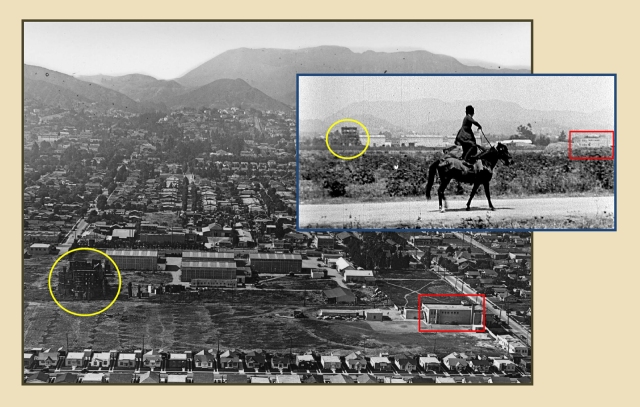
An equestrienne equipped with a shock absorber rides east down Melrose past the Hollywood Metropolitan Studios, still a studio site today, located along Santa Monica Boulevard at Las Palmas. Harold Lloyd operated as an independent producer from this studio beginning in 1924. This 1921 movie frame appears in the Kino-Lorber version of the film. hollywoodphotographs.com
My second post also shows how different versions of the film contain similar scenes filmed from different viewpoints. During the movie, Buster equips an equestrienne’s saddle with a truck shock absorber. Later in the film we see a panning shot of her struggling with her ride. The Kino-Lorber Blu-ray version of this panning shot (above) looks north as she rides east down Melrose near Las Palmas. Visual clues tell us this panning shot was filmed in 1921.
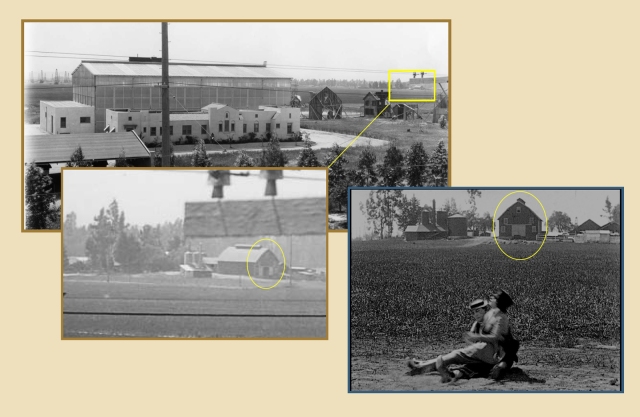
Looking SW from the Hollywood Metropolitan Studio towards the “La Brea” barn that appears in the Eureka Video Masters of Cinema version of The Blacksmith (right). Marc Wanamaker – Bison Archives
Keaton filmed many outdoor scenes from The Blacksmith near the still undeveloped intersection of Melrose and Highland. The above photo looks SW from the Hollywood Metropolitan Studio towards what I’ll call the “La Brea barn,” a classically proportioned barn that stood south of the SW corner of Melrose and La Brea. When Buster rescues Virginia Fox from a runaway horse, the La Brea barn appears behind them as they fall to the ground (above) in the Eureka Video Masters of Cinema version of the film (in the Kino-Lorber version (at left) Buster and Virgina fall into a haystack – confusing isn’t it?)

The La Brea barn also appears in this joke sunrise shot from The Scarecrow (left) as well as in the Eureka version of The Blacksmith right.
Keaton filmed the La Brea barn previously for a cartoonish joke of the rising sun popping up from the horizon introducing his 1920 short The Scarecrow.

At top, 1921, riding east along Melrose looking north (Kino-Lorber); immediately above, 1922, looking west, riding north up Highland past the La Brea barn and a landmark tree towards the Robin Hood set (Eureka).
The paired images above show two similar and ordinary panning shots of the troubled equestrienne appearing in different versions of the film. Filmed in 1921, the upper scene above appears in the Kino-Lorber version; the lower scene above, filmed in 1922, appears in the Eureka version. I don’t know why Keaton bothered refilming this unremarkable shot, but he could not have recreated the 1921 shot (riding east along Melrose) in 1922, because by that time so many homes and bungalows had been built between Melrose and the studio that the scene would have looked less “rustic.”

1921 – Buster rescues Virginia from her runaway horse. In the upper left two-shot image Buster touches Virginia’s shoulder before proposing to her, a scene unique to the Kino-Lorber version. The oval marks a prominent landmark tree NW of La Brea and Melrose.
The three scenes above were filmed in 1921. The upper left two-shot, where Buster taps Virginia’s shoulder, is unique to the Kino-Lorber version.

Click to enlarge. The two-shot of Virginia and Buster was filmed (heart) on Melrose east of Highland, looking west toward the landmark tree (oval). In the aerial view the once open-air Keaton Studio stage is now covered; the Robin Hood castle set has not yet been built at the Pickford-Fairbanks Studio. hollywoodphotographs.com
This complicated image above compares the two-shot of Buster and Virginia filmed in 1921, unique to the Kino-Lorber version, and the panning shot of the equestrienne, appearing only in the Eureka version, filmed in 1922, as the rider travels north up Highland (arrow) past the La Brea barn (triangle) and the landmark tree (oval). The aerial view places the shots relative to the nearby studios.
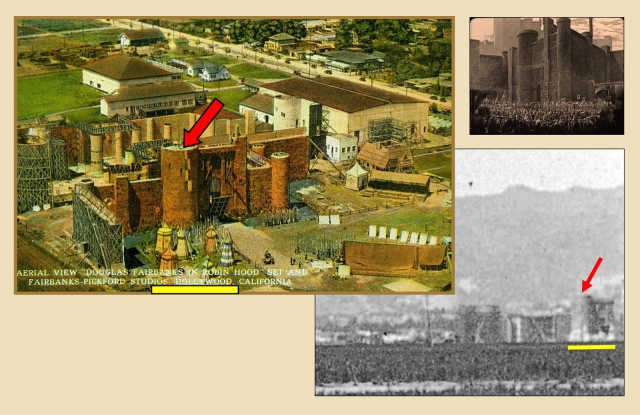
The far right (north) end of the 1922 equestrienne panning shot reveals the massive castle set built on the Pickford-Fairbanks Studio for the 1922 release Robin Hood. The yellow line above underscores the same group of tall tents. Upper right, the set, completed with a matte painting, as it appears in Robin Hood.
The far right end of the 1922 panning shot of the equestrienne riding north up Highland (two images above) provides a brief glimpse of the castle set built in 1922 for the Douglas Fairbanks production of Robin Hood.
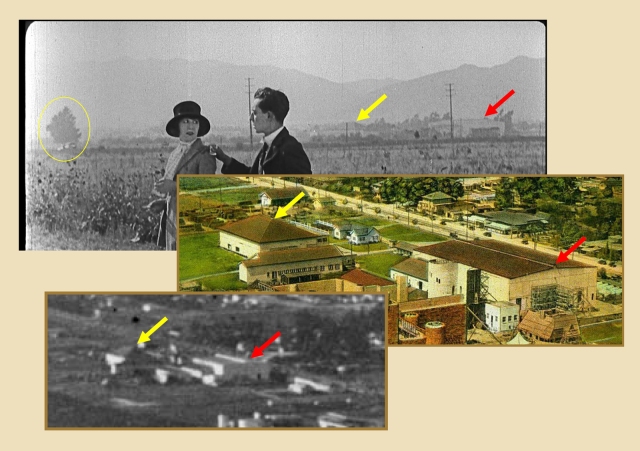
The 1921 two-shot of Virgina and Buster shows the Pickford-Fairbanks Studio stage (red arrow) before the Robin Hood castle set was built in 1922.
The two-shot above appears only in the Kino-Lorber version. Filmed in 1921, it shows the Pickford-Fairbanks Studio at back before the Robin Hood castle set was built there in 1922.
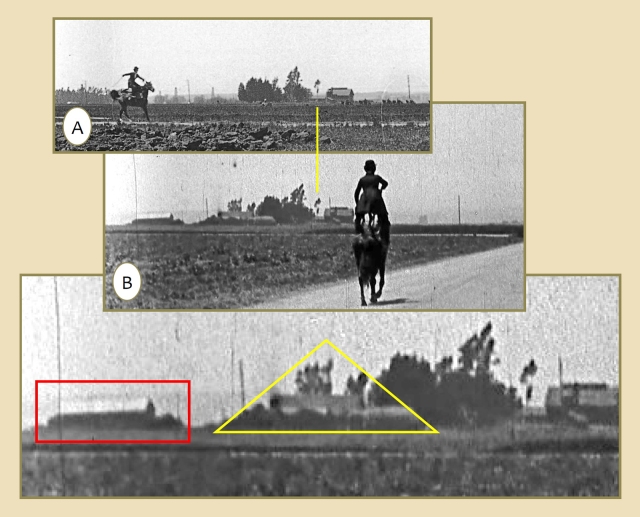
Scene (A) appears on the Eureka version, Scene (B ) appears as a supplement to the Kino-Lorber version. Both views look west towards the La Brea barn. The buildings and trees within the box and triangle were demolished during the many months that passed between the two takes.
Above, the equestrienne rides north up Highland in (A) and rides west on Melrose towards Highland in (B) in this pair of shots filmed looking west towards the La Brea barn. Neither shot appears in the Kino-Lorber version. Scene (A) was filmed in 1922, as the north end of the panning shot reveals the Robin Hood castle set in the background. Scene (B) was filmed in 1921, before all of the trees and buildings near the La Brea barn (within the box and triangle above) were demolished.
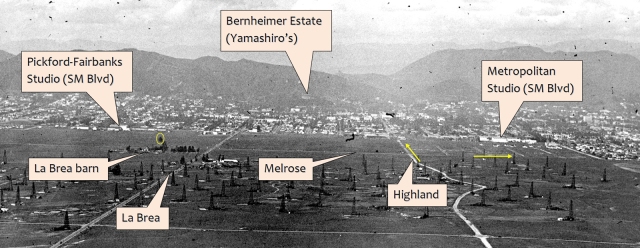
Click to enlarge. Looking north towards Hollywood. The oval marks the landmark tree, the arrows mark the two panning shots of the equestrienne’s path north up Highland and east along Melrose. Los Angeles Public Library
This part 3 post reveals Buster filmed scenes for The Blacksmith both before and after the Robin Hood castle set was built at the Pickford-Fairbanks Studio (Robin Hood began production in March 1922). My second post shows that a substantial amount of construction also took place near Highland between the time Keaton filmed scenes at the same spot (in the background an oil company expands from two tanks to three, and a lumber company building is extended). The aerial view above and detail view below show that the oil tank and lumber company construction was completed before the Robin Hood castle set was built. This means Buster could have filmed exteriors on three occasions; (i) the original early shots, (ii) shots after the Highland construction, but before the castle set was built, and (iii) later shots after the castle set was built.

This view was taken after the oil company added a third tank (oval) and the lumber company expanded (box), but before the Robin Hood castle set was built.
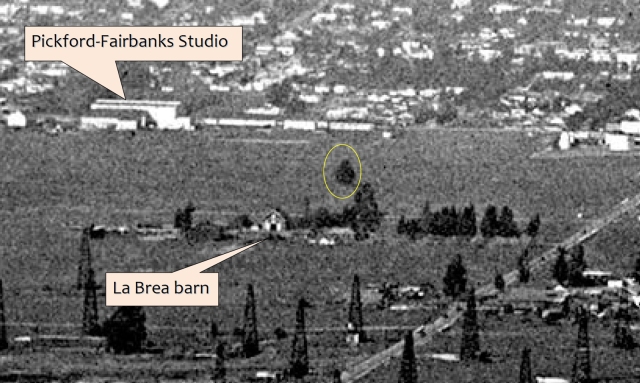
This detail from the same aerial image shows the landmark tree (oval) and the south face of the La Brea barn. Construction of the Robin Hood castle set has yet to commence.
While we may not be able to determine precisely when Keaton filmed the various exterior scenes for The Blacksmith, the visual evidence shown here and in my second post establishes that the earliest and latest scenes were filmed perhaps nine months or more apart.
NOTE: The version of The Blacksmith known in America today was discovered by James Mason in Keaton’s private vault (Mason was a subsequent owner of Keaton’s Italian Villa mansion in Beverly Hills). This “American” version appears to date from mid to late 1921, and does not contain any of the “Pena” scenes filmed in 1922. Thus, it is plausible Buster’s privately held 1921 vault print was not intended for wide distribution, and that the “Pena” version, containing numerous subsequently filmed gags, was the “official” version widely released in July 1922.
This article shows WHEN various scenes were filmed. We are still looking at the clues, but it is LIKELY that the Kino-Lorber version discussed above (i) comes from Keaton’s essentially “intact” vault print filmed in mid to late 1921, and that (ii) a couple of shots filmed much later were inserted in the Kino-Lorber version as part of the restoration, and that therefore (iii) these “later” insert shots do not change when the original Keaton vault print was filmed.
Kino-Lorber movie frames licensed by Douris UK, Ltd.; Eureka movie frame licensed Lobster Films, Paris.
The NW corner of Melrose and Higland today.



It’s always great when the mountains are visible in a shot – makes it a bit easier to nail down these locations. 😉
LikeLike
Pingback: Found – a new version of Keaton’s The Blacksmith and the tales it tells | Chaplin-Keaton-Lloyd film locations (and more)
Pingback: Found – a new version of Keaton’s The Blacksmith – part 2, more surprises | Chaplin-Keaton-Lloyd film locations (and more)
Pingback: The View Beyond Parallax… more reads for week of November 8 | Parallax View
Very impressive visual detective work!
LikeLike
Pingback: Guest Videos: The Geologist Who Lunged At Douglas Fairbanks With A Sword – Flight To Wonder
Pingback: Chaplin, Keaton, and Lois Weber’s “Suspense” in Beverly Hills | Chaplin-Keaton-Lloyd film locations (and more)